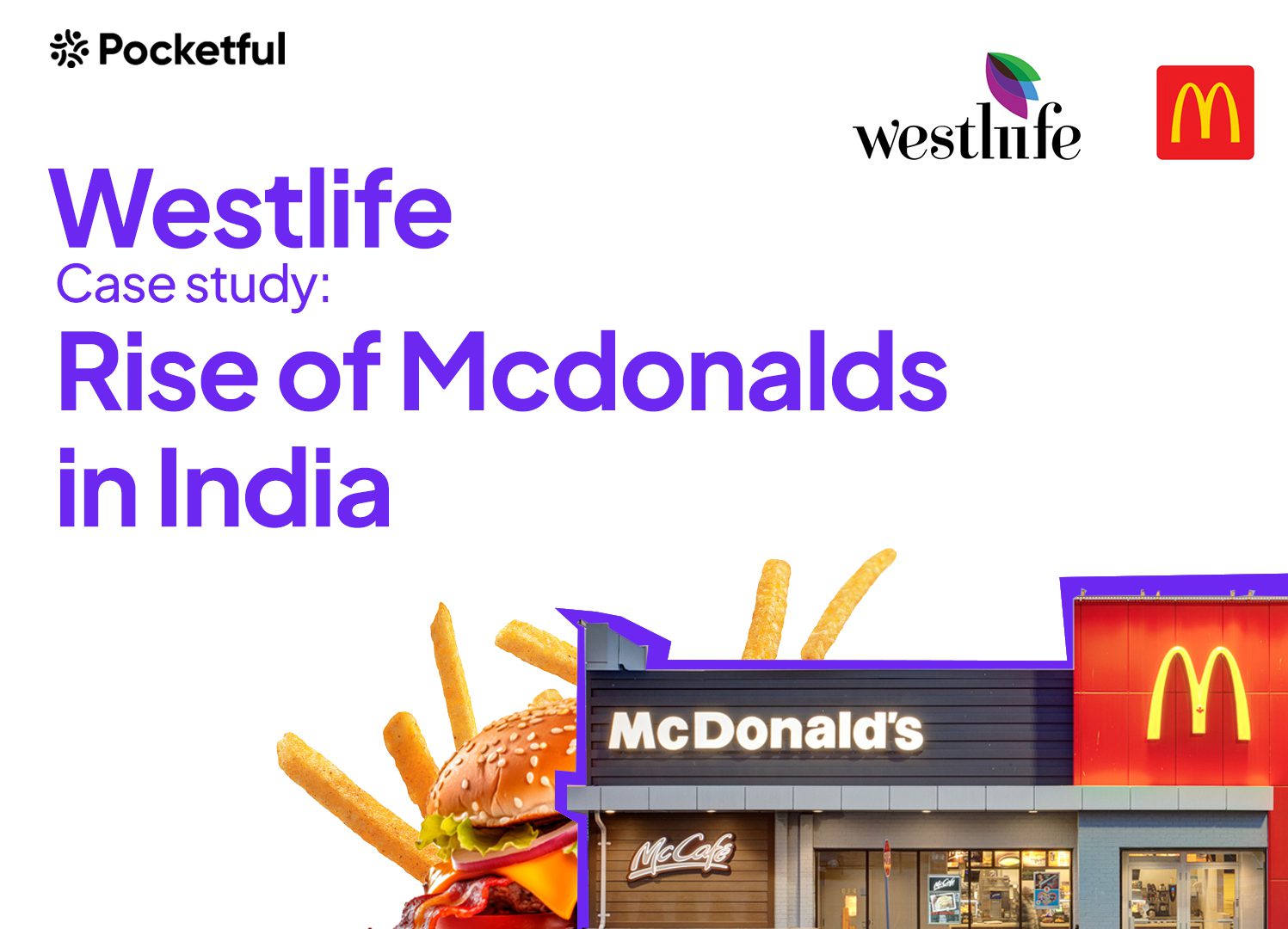| Type | Description | Contributor | Date |
|---|---|---|---|
| Post created | Pocketful Team | Mar-12-24 | |
| Add new links | Nisha | Feb-18-25 |

- Blog
- case study on westlife the rise of mcdonalds in india
Case Study on Westlife: The Rise of McDonalds in India

Do you know about Westlife Foodworld Limited? This company set foot in the Quick Service Restaurant industry in 1996 when it acquired the master franchise rights for McDonald’s in India. In this blog, we will explore the success story of Westlife in the Indian market.
About Westlife
The QSR (Quick Service Restaurants) industry has been experiencing unprecedented growth fueled by consumer demand. This massive growth happened recently and is expected to continue because of changing consumer preferences.
Westlife Foodworld Limited is responsible for establishing and operating the McDonald’s franchise in parts of West and South India. After remarkable success, the company became a beacon of inspiration and interest for investors and entrepreneurs.
The company established a strong presence in the nation’s West and South regions and saw a surge in revenue by 45% y-o-y to reach Rs 2,260 crore in FY23. The company provides excellent experiences to their customers, such as high-quality food, comfortable seating arrangements, consistent taste, etc. This is possible due to their robust supply chain and customer-centric policies.
The company has reported an EBITDA margin of 17.3 per cent – up 300 basis points bps y-o-y), PAT (profit after tax) increased to Rs 112 crore, and the Cash PAT margin improved by 11.2 per cent.
Let’s have a look at the key metrics of the company:
| Market Cap | ₹ 12,756 Cr. |
| Stock P/E | 144 |
| Current Price | ₹ 818 |
| High / Low | ₹ 1,025 / 639 |
| Book Value | ₹ 36.1 |
| Dividend Yield | 0.42 % |
| ROCE | 14.8 % |
| ROE | 21.7 % |
| Face Value | ₹ 2.00 |
Read Also: McDonald’s Marketing Strategy – Case Study
Overview of McDonald’s
It was established in 1940 in California by Richard and Maurice McDonald as a restaurant. This company serves delicious snacks like burgers and french fries, including chicken, fish, salads, and many more. The journey of “I’M Lovin’ it!” started around 25 years ago and later acquired the palette of the Indian market and enjoyed massive growth. Let’s dive into the company profile:
| Company type | Public |
| Industry | Fast food restaurants |
| Founded at | May 15, 1940 |
| Founded by | Richard McDonald, Maurice McDonald, Ray Kroc |
| Area served | Worldwide |
| Products | Burgers, chicken, french fries, soft drinks, soft serves, shakes, salads, desserts, hotcakes, coffee, breakfast, wraps |
Q3 impacted by the subdued business environment
- The SSSG (Same Store Sales Growth) in Q3FY24 stood at -9% Y-o-Y due to eating-out trends and other external challenges.
- Off-premises business boosted 3% Y-o-Y, majorly led by delivery & Drive-throughs as they contributed 42% of the total sales.
- Digital sales rose by 15%, contributing to 67% of the business.

How did McDonald’s conquer India?
As we know, McDonald’s has different types of customers nationwide. Indian families always prefer to go out with family members on the weekdays and weekends. Countries like India give McDonalds more exposure to spread the market. McDonald’s has a unique eating menu in India because of cultural diversification. Here we get a different menu including aloo tikki and french fries, not just traditional coke and burger.
Other than that, McDonald’s also focuses on college students and working professionals. But the question “How did McDonald’s grow rapidly in India?” remains unanswered. So, here are a few reasons why it happened.
- A Happy Meal includes different age groups, from children to adults, which means each age group will be happy with the order while being budget-friendly. By doing this, McDonald’s could retain all age groups as repeat customers. This feature gained immense popularity.
- McDonald’s is renowned for being consistent with their services to their customers.
- The company modified its menu regularly to cater to the market’s needs, such as incorporating burgers without onion and garlic during Navratri and creating makhani burgers to cater to people who like spicy food.
- McDonald’s rapidly expanded throughout the country, thus making it the go-to destination for families.
Read Also: Polycab Case Study: Business Model, Financials, Competitors, and Growth Outlook
Business Model and Growth Strategy
This industry is projected to grow remarkably in the upcoming years. The changing lifestyle, urban population, quick and convenient food options, and increasing income standards are the main reasons for the QSR industry’s massive growth potential. McDonald’s cracked the functionality framework and the customer acquisition. They carefully customized their menus per the state’s food preference, and they adapted to cultural norms by including vegetarian options in their food menus.
Business Model
McDonald’s mainly focuses on the franchise business model to generate a significant income, which is far more stable and predictable. They can leverage its market position to negotiate deals because it has control over the land and long-term leases. This is akin to a subscription, where the subscriber (the franchisee) pays a fixed monthly amount. The Franchise business gives a lot of revenue to the company and has a positive impact.
Growth Strategy
In 2017, the company introduced the Velocity Growth Plan, citing the center of the plan as a customer centric strategy, primarily focusing on the business, food, value, and customer experience. Here are the main factors considered in the plan:
- Retaining: The plan mainly focuses on the areas where customers have a strong foothold.
- Regain: It mainly focuses on the areas of the customer where the company lost a significant share of customers because of factors like food taste, competition, pricing, etc.
- Convert: It also focuses on gaining new customers by offering additional items on the menu, like coffee and snacks.

Read Also: Nestle India Case Study: Business Model, Financial Statement, SWOT Analysis
Conclusion
In this blog, we concluded how McDonald’s conquered the Indian market, growth strategies, marketing strategies, reports related to FY23, and many more. In conclusion, the rise of McDonald’s in India through Westlife Foodworld Limited showcases a successful business model focusing on customer needs, quality food, and strategic growth strategies. McDonald’s ability to adapt to local preferences and offer a diverse menu has immensely contributed to its rapid expansion and sustained success in the Indian market.
Frequently Asked Questions (FAQs)
Why did McDonald’s succeed in India?
The success mantra implemented was adapting Indian Food tastes and preferences in their food menus.
Who was McDonald’s target customer in India?
Children, families, working employees, and adults were all the targeted customers of McDonald’s.
Who is McDonald’s main competitor?
Burger King, KFC, Burger Singh, etc. are the main competitors of McDonalds.
When did McDonald’s come to India?
Westlife started operations for McDonald’s in the year of 1996 in India.
Who heads Westlife Foodworld?
Amit Jatia heads Westlife as the Chief Executive Officer (CEO).
Disclaimer
The securities, funds, and strategies discussed in this blog are provided for informational purposes only. They do not represent endorsements or recommendations. Investors should conduct their own research and seek professional advice before making any investment decisions.